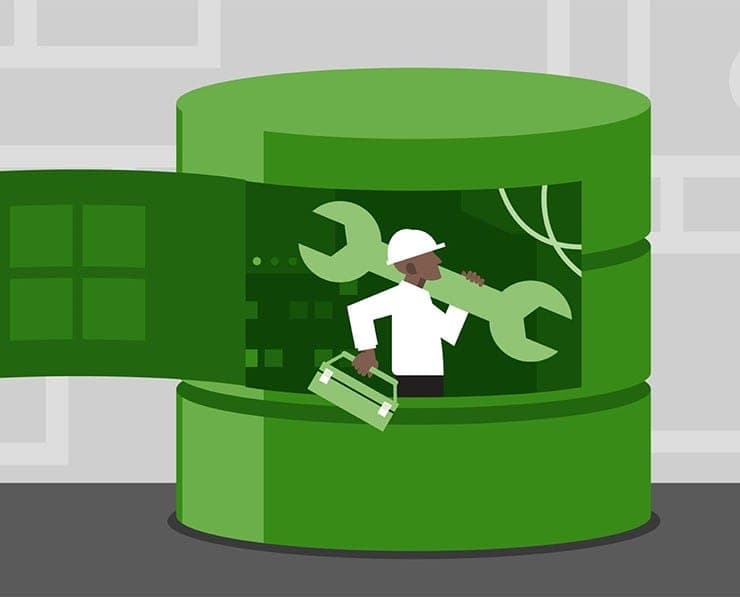Student Feedback
AZ-303: Microsoft Azure Architect Technologies Certification Video Training Course Outline
Introduction
Implement Azure Infrastructure
Implementing Security
Implement Management Solutions
Implement Solutions for Apps (10...
Implement and Manage Data Platfo...
Monitor Azure Infrastructure
Introduction
AZ-303: Microsoft Azure Architect Technologies Certification Video Training Course Info
Microsoft Azure Architect Technologies AZ-303: Complete Prep Course
Showcase your expertise in Azure Architecture by completing the AZ-303 certification course.
What you will learn from this course
Understand the core architecture of Microsoft Azure and its global infrastructure
Design scalable and resilient cloud solutions using Azure services
Configure and implement Azure compute, networking, storage, and security services
Gain practical knowledge to pass the Microsoft AZ-303 Azure Architect Technologies certification exam
Learn to implement governance, monitoring, and cost management in Azure environments
Explore advanced Azure solutions including hybrid cloud, identity management, and high availability strategies
Stay current with the latest Azure updates, services, and best practices
Acquire hands-on experience with real-world scenarios to design secure, scalable, and highly available solutions
Learning Objectives
By the end of this course, learners will be able to:
Design infrastructure solutions that meet business and technical requirements on Azure
Implement and manage storage accounts, virtual networks, and virtual machines effectively
Design secure and compliant architectures that integrate Azure security services
Implement identity and access management using Azure Active Directory and role-based access control
Design and deploy high-availability and disaster recovery solutions
Monitor, optimize, and troubleshoot cloud solutions for performance and cost efficiency
Integrate on-premises resources with cloud services to enable hybrid solutions
Evaluate and implement automation strategies using Azure tools and scripting solutions
Target Audience
This course is designed for:
IT professionals aiming to transition into Azure cloud architecture roles
Solution architects seeking certification as Microsoft Azure Architects
Cloud engineers looking to deepen their knowledge in designing scalable and secure Azure solutions
Technical leads and managers who want to understand Azure best practices for enterprise deployments
Professionals preparing for the AZ-303 exam who require a structured and comprehensive study path
Individuals seeking practical hands-on experience with real-world Azure implementations
Requirements
To get the most out of this course, participants should have:
Access to a free or paid Microsoft Azure subscription to practice hands-on labs and exercises
A basic understanding of cloud computing concepts and networking fundamentals
Familiarity with virtualization, operating systems, and data storage concepts
An interest in cloud architecture, solutions design, and enterprise technology deployments
Motivation to learn and explore new Azure services and technologies as Microsoft updates its platform regularly
Prerequisites
Before starting this course, learners should have:
Experience with Azure portal navigation and core Azure services
Knowledge of virtual machines, storage accounts, and virtual networks in Azure
Familiarity with cloud security principles and identity management concepts
Understanding of enterprise IT infrastructure including on-premises data centers
Basic experience with scripting or automation using PowerShell or Azure CLI
Awareness of common enterprise architecture patterns and IT governance requirements
The Microsoft Azure AZ-303 Azure Architect Technologies course is structured to build a strong foundation in Azure cloud architecture while progressively guiding learners through advanced concepts. By focusing on hands-on labs, scenario-based exercises, and detailed explanations, participants will be equipped with the knowledge and practical skills required for designing, deploying, and managing complex cloud solutions. Azure has become a critical skill set in modern IT, and understanding its services and architecture will prepare learners for high-demand cloud roles.
Microsoft Azure provides a flexible, scalable, and reliable platform for enterprises of all sizes. Professionals trained in Azure architecture can design solutions that meet performance, scalability, and security requirements while optimizing costs and operational efficiency. This course emphasizes these principles throughout, ensuring that learners not only understand theoretical concepts but also how to apply them in real-world scenarios.
Cloud adoption is growing rapidly across industries, and businesses increasingly require skilled architects who can navigate complex cloud environments. The AZ-303 certification validates the skills necessary to architect solutions on Microsoft Azure, including integrating services, implementing security controls, and designing for high availability and disaster recovery. By completing this course, learners will gain confidence in their ability to manage these responsibilities and enhance their professional credentials.
Participants will explore multiple Azure services, including compute resources such as virtual machines, Azure Kubernetes Service, and app services. They will learn to implement storage solutions, including blob, file, and database services, while understanding how to ensure data security and compliance. Networking concepts such as virtual networks, subnets, VPN gateways, and load balancers are covered in depth, providing the foundation for designing highly available and secure architectures.
Identity and access management is a crucial area for Azure Architects. This course covers Azure Active Directory, conditional access, multi-factor authentication, and role-based access control, enabling learners to design solutions that protect resources and comply with organizational policies. Additionally, monitoring, logging, and governance are addressed to ensure that solutions are maintainable, auditable, and optimized for cost and performance.
Hybrid cloud solutions are increasingly common, and this course provides guidance on integrating on-premises infrastructure with Azure resources. Learners will gain insight into site-to-site VPNs, ExpressRoute, and other hybrid connectivity options, enabling seamless integration of legacy and cloud systems. Disaster recovery and backup solutions are also covered, ensuring that learners can design architectures that meet business continuity requirements.
The course is designed for flexibility. Experienced professionals can focus on areas where they need to strengthen skills, while newcomers can follow a comprehensive path from fundamental to advanced topics. All modules include references to additional resources for learners who want to explore services in greater depth, reinforcing practical knowledge and exam readiness.
Course Modules / Sections
The AZ-303 Azure Architect Technologies course is organized into carefully structured modules, each designed to provide comprehensive coverage of specific Azure services and architectural patterns. Each section focuses on both theoretical concepts and practical application, ensuring learners can confidently design and implement enterprise-grade cloud solutions. The course is divided into the following main sections:
Introduction to Azure Architecture and Core Services
This section provides an overview of Microsoft Azure, its global infrastructure, and the essential components that form the foundation of cloud solutions. Learners explore the Azure portal, subscription and resource management, and the shared responsibility model. The section also introduces high-level cloud architecture principles and best practices for scalability, resilience, and cost optimization.Azure Compute Solutions
This module focuses on compute resources, including virtual machines, virtual machine scale sets, Azure App Services, and Azure Kubernetes Service. Learners explore deployment options, configuration settings, and scaling strategies to design efficient compute environments. The section emphasizes performance optimization, security best practices, and integration with other Azure services.Networking and Connectivity
Networking is a critical component of any cloud architecture. This section covers virtual networks, subnets, network security groups, route tables, VPN gateways, and ExpressRoute. Learners understand how to design secure and resilient network topologies, implement hybrid connectivity with on-premises infrastructure, and configure advanced networking features such as load balancing, traffic management, and application gateways.Azure Storage Solutions
Storage services are essential for modern applications. This section covers Azure Storage accounts, blob storage, file storage, queues, tables, and database services such as Azure SQL Database and Cosmos DB. Learners learn how to choose the appropriate storage type based on performance, availability, and security requirements. Strategies for data redundancy, backup, and disaster recovery are also discussed in detail.Identity, Security, and Governance
Managing access and securing resources is a critical responsibility of Azure architects. This module explores Azure Active Directory, role-based access control, conditional access, and multi-factor authentication. Learners gain expertise in implementing security policies, auditing, compliance, and governance frameworks to ensure secure, compliant cloud solutions.Monitoring, Optimization, and Cost Management
Azure solutions must be efficiently monitored and optimized. This section introduces Azure Monitor, Azure Log Analytics, and Application Insights to provide insights into system performance, availability, and usage. Learners also explore cost management tools, budgeting strategies, and optimization techniques to minimize cloud expenses while maintaining performance and reliability.High Availability and Disaster Recovery
Ensuring business continuity is vital in cloud architecture. This module covers concepts such as availability sets, availability zones, and region pairs. Learners understand disaster recovery planning, backup strategies, replication options, and failover mechanisms to design resilient solutions that meet organizational requirements.Hybrid and Multi-Cloud Solutions
Organizations often adopt hybrid and multi-cloud strategies. This section provides guidance on integrating on-premises systems with Azure resources, using site-to-site VPNs, ExpressRoute, and Azure Arc. Learners explore strategies for managing distributed environments, ensuring security, and enabling seamless connectivity across multiple platforms.Automation and DevOps Integration
Modern cloud environments benefit from automation and DevOps practices. This module introduces Azure Resource Manager templates, Azure CLI, PowerShell scripting, and Azure DevOps pipelines. Learners gain hands-on experience in automating deployment, configuration, and operational tasks, increasing efficiency and reducing the risk of errors.
Key Topics Covered
The AZ-303 course covers a wide range of essential topics, ensuring learners develop a deep understanding of Azure architecture and services. Key topics include:
Azure Infrastructure and Core Services
Exploring subscriptions, resource groups, regions, availability zones, and the shared responsibility model. Understanding cloud service models (IaaS, PaaS, SaaS) and their application in enterprise solutions.Compute Solutions
Implementing virtual machines, scale sets, containers, and serverless computing. Configuring auto-scaling, load balancing, and high-availability strategies. Integrating compute resources with storage, networking, and identity services.Networking and Security
Designing secure network architectures with virtual networks, subnets, and network security groups. Implementing firewalls, traffic routing, load balancing, and hybrid connectivity. Managing DNS, VPNs, ExpressRoute, and application gateways.Storage and Data Services
Implementing blob, file, table, and queue storage. Configuring databases, including Azure SQL Database, Cosmos DB, and MySQL/PostgreSQL services. Ensuring data redundancy, backups, and disaster recovery. Managing storage security, encryption, and access policies.Identity and Access Management
Implementing Azure Active Directory, conditional access, multi-factor authentication, and single sign-on. Configuring role-based access control, privileged identity management, and monitoring access and compliance.Monitoring, Performance, and Optimization
Using Azure Monitor, Log Analytics, and Application Insights to track performance, diagnose issues, and optimize resources. Implementing cost management and budgeting strategies to control cloud spending.High Availability and Disaster Recovery
Designing solutions with availability sets, zones, and region pairs. Implementing backup, replication, and failover mechanisms to ensure business continuity. Evaluating recovery time objectives and recovery point objectives.Hybrid and Multi-Cloud Architectures
Integrating on-premises environments with Azure using VPNs, ExpressRoute, and Azure Arc. Designing solutions that support multi-cloud deployment and hybrid connectivity. Managing security, compliance, and operational workflows across environments.Automation and DevOps Practices
Using Azure Resource Manager templates, CLI, PowerShell, and DevOps pipelines to automate deployment and configuration. Implementing infrastructure as code, CI/CD pipelines, and automated monitoring and remediation.Exam-Focused Preparation
Mapping all lessons and topics to the AZ-303 exam objectives. Providing hands-on labs, scenario-based exercises, and practice questions to ensure readiness for certification.
Teaching Methodology
The AZ-303 course is designed with a hands-on, practical approach that ensures learners gain both theoretical knowledge and real-world experience. The teaching methodology includes:
Interactive Video Lessons
High-quality video lectures provide step-by-step demonstrations of Azure concepts, configuration, and implementation. Complex topics are broken down into manageable segments for easy comprehension.Hands-On Labs and Exercises
Learners perform real-world tasks in Azure environments, including virtual machine deployment, network configuration, database setup, and identity management. These labs reinforce concepts and prepare learners for practical scenarios.Scenario-Based Learning
The course presents realistic enterprise scenarios, allowing learners to apply knowledge to design secure, scalable, and optimized solutions. This approach bridges the gap between theory and practice.Continuous Updates
The course content is regularly updated to reflect changes in Azure services, exam objectives, and industry best practices. Learners receive access to the latest material to ensure relevance and accuracy.Study Guides and Resources
Downloadable study guides, diagrams, and reference materials provide additional support for exam preparation. Links to official documentation and recommended readings allow learners to explore topics in depth.Instructor Support
Participants can ask questions within the course platform and receive guidance from experienced instructors. This support ensures learners understand concepts and can overcome challenges effectively.Self-Paced Learning
The course is structured for flexibility, enabling learners to progress at their own pace. Experienced professionals can skip familiar sections while focusing on areas requiring deeper understanding.Practical Demonstrations
Step-by-step demonstrations cover setup, deployment, configuration, monitoring, and troubleshooting of Azure services. Learners gain confidence through repeated exposure to real-world tasks.
Assessment & Evaluation
The course includes multiple evaluation methods to ensure learners achieve mastery of the AZ-303 exam objectives and practical skills:
Hands-On Labs Completion
Learners are assessed on completing labs that simulate real-world enterprise environments. Successful completion demonstrates practical competence in Azure deployment and configuration.Quizzes and Knowledge Checks
Each module includes quizzes and knowledge checks to reinforce key concepts. Immediate feedback helps learners identify strengths and areas needing improvement.Scenario-Based Assignments
Assignments based on realistic business scenarios require learners to design, deploy, and troubleshoot Azure solutions. These exercises develop problem-solving and decision-making skills relevant to professional roles.Progress Tracking and Reporting
The course platform tracks progress, completion rates, and assessment results. Learners can monitor their readiness and focus on areas where improvement is needed.Certification Readiness Tests
Practice exams aligned with AZ-303 objectives allow learners to simulate the certification experience. Results highlight knowledge gaps and ensure exam readiness.Instructor Evaluation and Feedback
Learners can receive guidance and feedback from instructors on assignments, labs, and practice exercises. Personalized feedback helps refine skills and understanding.Self-Assessment Opportunities
Additional self-assessment tools, such as flashcards, checklists, and review exercises, reinforce learning and help learners retain critical information.Continuous Improvement Focus
Learners are encouraged to revisit lessons, explore additional resources, and perform repeated hands-on exercises to build confidence and expertise.
The combination of structured modules, practical labs, scenario-based learning, and regular assessments ensures that participants are well-prepared for the AZ-303 certification exam. The focus on real-world application equips learners with the skills required to design, deploy, and manage complex Azure solutions effectively, ensuring career readiness in the rapidly growing cloud computing industry.
Benefits of the Course
The AZ-303 Azure Architect Technologies course provides numerous advantages for professionals seeking to advance their careers in cloud computing. By completing this course, learners gain both theoretical knowledge and practical experience in designing, deploying, and managing Azure cloud solutions. Participants develop the expertise necessary to pass the Microsoft AZ-303 certification exam and enhance their professional credibility.
One of the primary benefits is the structured approach to mastering Azure services and architecture. Learners are guided through complex topics, from compute, networking, and storage to identity, security, and governance. This comprehensive coverage ensures that participants have a well-rounded understanding of cloud architecture principles, enabling them to design robust and efficient solutions that meet organizational requirements.
The course emphasizes hands-on experience with real-world scenarios. Through lab exercises, learners implement and configure Azure resources, allowing them to apply theoretical concepts in practical situations. This experiential learning helps reinforce knowledge and builds confidence in performing tasks that mirror professional responsibilities.
Another significant benefit is the alignment of course content with the AZ-303 exam objectives. Each module is designed to cover specific exam domains, ensuring learners focus on the skills and knowledge required for certification. By combining lessons, labs, and assessments, the course prepares participants to pass the exam on their first attempt.
Participants also gain exposure to the latest updates in Azure services and emerging cloud technologies. Microsoft Azure evolves rapidly, and staying current with new tools, features, and best practices is critical for architects. The course content is continually updated, allowing learners to stay informed about changes and enhancements that impact cloud solution design.
Career advancement is another key benefit. Azure architects are in high demand, and certified professionals are often sought after by organizations looking to migrate workloads, optimize cloud environments, and implement secure, scalable solutions. By acquiring AZ-303 certification, learners improve their employability, position themselves for leadership roles, and can command competitive salaries in the cloud computing industry.
Additionally, the course fosters problem-solving, decision-making, and critical thinking skills. Learners encounter scenarios that require them to evaluate requirements, consider trade-offs, and design solutions that balance cost, performance, and security. These skills are essential for professionals who must make informed decisions in real-world cloud deployments.
Networking opportunities are another indirect benefit. Learners participating in this course may engage with peers, instructors, and online communities, creating connections with other Azure professionals. Such networks provide support, collaboration opportunities, and insights into industry trends and best practices.
Finally, the course encourages continuous learning. Azure technology is ever-evolving, and professionals must maintain their knowledge to remain effective. By cultivating the habit of exploring new services, features, and design patterns, learners establish a foundation for lifelong growth in cloud architecture and technology leadership.
Course Duration
The AZ-303 course is designed to be comprehensive yet flexible, allowing learners to progress at a pace that suits their schedule. The total duration of the course is approximately 40 to 50 hours of instructional content, with additional time allocated for hands-on labs, exercises, and practice assessments.
Learners can complete the course over a few weeks with consistent study or spread the modules over several months to accommodate professional and personal commitments. Each module is broken down into smaller lessons, making it easier to digest complex topics without feeling overwhelmed.
Hands-on labs and scenario exercises are integrated throughout the course, requiring additional time for completion. These practical exercises are critical for reinforcing theoretical concepts and building proficiency in implementing Azure solutions. Learners are encouraged to spend sufficient time on labs to gain confidence in performing real-world tasks.
Self-paced learning allows participants to revisit lessons, review modules, and practice configurations multiple times. This flexibility ensures that learners can fully understand concepts before moving on to more advanced topics. The ability to repeat exercises also improves retention and prepares participants for the certification exam.
Practice assessments and quizzes are included in each module to gauge understanding and track progress. Completing these assessments adds to the overall course duration but is essential for ensuring learners are ready for the AZ-303 exam. The course also includes downloadable study guides and reference materials, which learners can use to supplement their study time.
The combination of video lessons, labs, assessments, and self-study ensures that participants receive both depth and breadth of knowledge. While the official instructional content may take 40 to 50 hours, learners should plan for additional practice time to achieve mastery of all topics.
By spreading the learning over a reasonable timeframe, participants can balance professional responsibilities with study, ensuring a thorough and effective preparation experience. The course structure accommodates both fast-track learners who want to complete the training quickly and those who prefer a slower, in-depth approach.
Tools & Resources Required
To maximize the benefits of the AZ-303 course, learners require access to specific tools and resources. These resources facilitate hands-on practice, enable practical learning, and support the development of skills necessary for cloud architecture roles.
A Microsoft Azure subscription is essential for performing labs and exercises. Learners can use either a free Azure account, which provides limited access to core services, or a paid subscription that allows full access to enterprise-grade features. Access to Azure ensures that participants can implement virtual machines, networking, storage, and security configurations in a real cloud environment.
A modern computer with internet access is required to run Azure portal, PowerShell, and CLI tools efficiently. While most lab exercises can be performed through the web interface, some tasks may require additional tools for automation, scripting, or command-line operations. A stable internet connection is necessary to ensure uninterrupted access to cloud resources and course content.
Familiarity with web browsers, basic operating system management, and standard productivity software is recommended. Learners will frequently use the Azure portal and may need to navigate documentation, download templates, and manage files for lab exercises.
PowerShell and Azure CLI are critical tools for automating deployments and performing configuration tasks. Learners are encouraged to install the latest versions and become comfortable using command-line interfaces to interact with Azure services. These tools are widely used in professional environments and are essential for exam readiness.
Integrated development environments (IDEs) such as Visual Studio Code may be used for scripting, template creation, and managing Azure resources programmatically. These tools enhance productivity and allow learners to practice real-world scenarios involving infrastructure as code.
Access to official Microsoft documentation and learning resources is highly recommended. The course provides links and references to updated guides, best practices, and architectural patterns. Exploring these resources allows learners to gain additional insights and ensures they remain current with changes to Azure services and features.
Downloadable study guides, PDFs, and practice exercises provided within the course are valuable supplementary resources. Learners should utilize these materials for review, note-taking, and structured exam preparation.
Optional third-party tools such as diagramming software, cloud monitoring solutions, and code repositories can enhance learning by allowing learners to visualize architectures, simulate deployments, and organize lab exercises efficiently.
Overall, the combination of an Azure subscription, command-line tools, IDEs, official documentation, and course-provided resources equips learners to fully engage with the course content, practice skills effectively, and prepare for certification.
The careful integration of theory, practical tools, and structured resources ensures that learners can apply concepts confidently, reinforce learning through hands-on experience, and achieve the objectives of the AZ-303 Azure Architect Technologies course. By utilizing these tools, learners gain the technical foundation required for designing, deploying, and managing enterprise-scale Azure solutions while preparing for professional certification.
Career Opportunities
Completing the AZ-303 Azure Architect Technologies course opens a wide range of career opportunities in the cloud computing and IT architecture sectors. Microsoft Azure is one of the most widely adopted cloud platforms globally, and certified professionals are in high demand across industries. Organizations of all sizes require skilled architects to design, implement, and manage complex cloud solutions.
One of the primary career paths for graduates of this course is the role of Azure Solutions Architect. Professionals in this position are responsible for creating scalable, secure, and highly available cloud solutions. They design infrastructure, implement best practices for governance and security, and integrate Azure services to meet business needs. An Azure Solutions Architect must also optimize cost, performance, and compliance, making this role critical for modern enterprises.
Another key opportunity is Cloud Infrastructure Engineer. These professionals focus on implementing, managing, and monitoring cloud environments, ensuring that applications and services operate efficiently. With AZ-303 certification, individuals can demonstrate the technical expertise required to configure virtual machines, networking, storage, and identity services in Azure.
Cloud Consultant positions are also accessible to certified individuals. Consultants help organizations migrate workloads to Azure, optimize existing cloud environments, and implement best practices for architecture and governance. Their responsibilities often include assessing business requirements, recommending solutions, and providing guidance on cost management and cloud strategy.
DevOps Engineer roles are closely related to cloud architecture and are suitable for AZ-303 graduates. These professionals work to automate deployment pipelines, manage infrastructure as code, and implement monitoring and continuous integration strategies. Knowledge of Azure services, automation tools, and hybrid cloud integration makes AZ-303-certified professionals highly qualified for these roles.
IT Project Manager and Technical Lead positions benefit from AZ-303 certification because understanding cloud architecture allows professionals to plan, execute, and oversee cloud-based projects effectively. Technical knowledge combined with management skills enables leaders to coordinate teams, manage resources, and ensure successful project delivery.
The demand for Azure-certified professionals spans industries, including finance, healthcare, retail, manufacturing, and technology. As organizations increasingly migrate to cloud platforms, the need for experts capable of designing secure, resilient, and cost-effective solutions continues to grow. Certified individuals can pursue opportunities in both multinational corporations and specialized cloud consulting firms, with salaries reflecting the advanced skill set required.
Freelance and independent consulting opportunities are also available for AZ-303-certified professionals. Organizations often require temporary expertise to design or optimize cloud solutions, making project-based consulting a viable career path. Freelancers benefit from flexible schedules, diverse project experiences, and competitive compensation.
Additionally, career growth is supported by the continuous evolution of Azure services. Certified professionals can expand their expertise into areas such as artificial intelligence, machine learning, Internet of Things, and hybrid cloud solutions. The AZ-303 course provides a strong foundation for specialization, enabling learners to explore advanced certifications and niche roles within the cloud ecosystem.
The combination of high demand, competitive compensation, and diverse career pathways makes AZ-303 certification a valuable investment for IT professionals. Graduates are well-positioned to take on leadership roles, drive cloud strategy, and contribute to organizational success by leveraging their skills in designing and managing complex Azure architectures.
Conclusion
The AZ-303 Azure Architect Technologies course offers comprehensive training for individuals seeking to become proficient in Microsoft Azure cloud architecture. The course covers a wide array of topics, including compute, storage, networking, identity, security, governance, automation, and hybrid cloud solutions. Learners gain both theoretical knowledge and hands-on experience, ensuring they are fully prepared to design, deploy, and manage complex cloud solutions.
Completing this course equips participants with the skills required to pass the AZ-303 certification exam, providing validation of their expertise and enhancing their professional credibility. The structured modules, practical labs, scenario-based learning, and assessment tools are designed to ensure mastery of exam objectives and readiness for real-world challenges.
In addition to certification preparation, the course offers career advantages. Azure architects are highly sought after in the global market, and certified professionals can pursue roles such as Azure Solutions Architect, Cloud Infrastructure Engineer, DevOps Engineer, Cloud Consultant, Technical Lead, and IT Project Manager. These roles offer competitive compensation, opportunities for advancement, and exposure to cutting-edge technologies and enterprise-scale projects.
The continual updates to the course content ensure learners remain current with Azure’s evolving services and best practices. Microsoft Azure is constantly expanding, and staying informed is critical for designing effective, scalable, and secure solutions. By completing the AZ-303 course, learners gain confidence in their ability to leverage Azure services effectively and adapt to technological advancements.
The course also emphasizes the practical application of concepts through hands-on labs, exercises, and scenario-based tasks. Learners gain real-world experience in deploying, configuring, monitoring, and optimizing cloud solutions. This experiential approach ensures that knowledge is not just theoretical but can be applied immediately in professional environments, providing tangible skills that enhance employability.
Microsoft Azure’s widespread adoption and continued growth make expertise in cloud architecture a highly valuable asset. Organizations are increasingly reliant on cloud services for operational efficiency, innovation, and digital transformation. Certified Azure architects play a crucial role in guiding these initiatives, making AZ-303 certification a significant career differentiator.
By enrolling in this course, learners invest in their professional development, acquiring the skills, knowledge, and confidence needed to succeed in the cloud computing industry. The comprehensive coverage of Azure services, combined with practical exercises and exam-focused preparation, ensures that participants are equipped for both certification and real-world cloud architecture challenges.
Enroll today
Taking the next step in your cloud career is simple. Enrolling in the AZ-303 Azure Architect Technologies course provides access to complete, up-to-date instructional content, hands-on labs, scenario-based exercises, and study resources. Participants gain the knowledge and practical skills required to pass the Microsoft AZ-303 certification exam and excel in professional roles as Azure architects.
Learners can start at their own pace, with the flexibility to revisit lessons, practice labs, and explore additional resources as needed. The course is suitable for IT professionals, solution architects, cloud engineers, and technical leads seeking comprehensive preparation for certification and career advancement.
Enroll today to gain expertise in Microsoft Azure, enhance your professional credentials, and open the door to high-demand career opportunities in cloud architecture. By completing the course, you position yourself to design scalable, secure, and optimized Azure solutions while demonstrating your ability to meet the evolving needs of modern enterprises.
The AZ-303 course equips learners with the knowledge, skills, and confidence required to succeed in a competitive cloud computing environment. Enrolling today sets you on a path toward certification, career growth, and mastery of one of the most widely used and rapidly evolving cloud platforms in the world.













